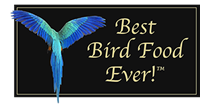
Crimson-winged parrot, male.
‘Old Bird Feeding Customs’
Due to the flirtations of a male Crimson-winged parrot, he and his hen were the first birds to join my family. With them in my life I quickly discovered how little information there was available on using natural and holistic care methods with birds. Even more discouraging was the seemingly rote advice about proper nutrition for a parrot. The general consensus was to feed dry seeds, pellets made from ingredients I didn’t consider to be safe let alone healthy, with an occasional piece of fresh apple or steamed vegetable. Crazy Corn™ a mixture of whole corn, legumes, and beans intended to be fed to birds after being cooked was also available. This product added variety and vegetable-based protein to the diet, but it was not organic. I knew there had to be more. This awareness lead me to begin exploring what it meant to feed my parrots and finches Balanced Avian Nutrition.
.
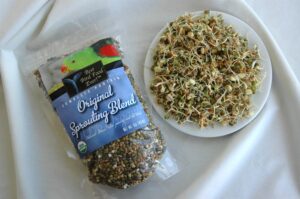
The Best Bird Food Ever! Complete Protein Sprouting Blend and at 3 days growth-ready to feed.
In the Beginning
Then I discovered sprouting and an entire world of healthier, more nutritious foods became a part of my life with my birds. However, all the sprouting blends that were available were poorly formulated, and lacked nutrients I knew were essential for the health of my birds. So I created the BBFE Compete Protein Sprouting Blends. As my knowledge of proper sprouting for parrots and finches grew, I also had to discover new and creative ways of encouraging my parrots to sample and begin eating the new foods so foreign to them, but vital for their health and well-being. I’ve now become very skilled at teaching parrots and finches to eat, and enjoy, healthier new foods.
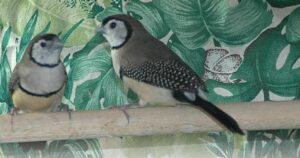
Owl Finch pair, Leslie’s birds.
My Early Avian Holistic Work
As my interests expanded I began breeding Owl finches. My work with them laid the foundation for the natural and holistic work I am now using with parrots. Seeing positive results in finches when using classical homeopathy, more complete nutrition, specific nutritional supplements, certain medicinal herbs, and healing and communication work illustrated that birds could receive the healing benefits of natural and holistic care too.
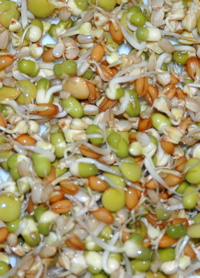
Our Complete Protein, Original Sprouting Blend, properly grown, three days growth.
Nutritional Balance- A Must!
Providing a variety of foods that provides parrots and finches Balanced Nutrition is an essential part of avian nutrition. Obtaining organic foods and ingredients can have such a positive impact on the health and well-being of your feathered companions. For a more detailed explanation follow this link and read “Why Feed Organic?” .
I have seen the best results are achieved when a bird’s diet consists of feeding a combination of foods that provide a ‘Balanced Exotic Avian Food Plan’. And this Balanced Food Plan uses our BBFE sprouts as the main because because of the superior and balanced nutrition it contains.
.
The Power of Sprouts
The right sprouting formula contains a power house of nutrients. During the sprouting process amino acids are altered creating a higher quality of usable protein. Vitamin levels increase dramatically and the minerals present become chelated. This means they combine with protein in a way that amkes them easier to assimilate. Sprouts are easily grown at home in your kitchen. But remember, the blend you’re sprouting for your birds must contain compete protein. Why? Because complete protein is first–an essential nutrient that your birds must eat everyday. And, secondly, compete protein is the most important nutrient missing in the exotic avian diet today. BBFE has been specially formulated to provide your birds Complete protein.
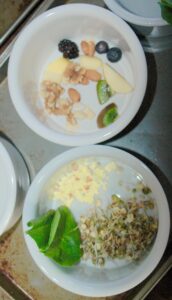
A nutritionally balanced Macaw-sized meal.
My Approach to Balanced Avian Nutrition
In addition to feeding our BBFE sprouts, I suggest feeding fresh fruits, and raw or steamed vegetables. In place of feeding pellets I cook BBFE as a Mash and feed that. Here’s a link to the recipe: Feeding Parrots: BBFE Mash. For more information on my ‘Balanced exotic Avian Food Plan’ you can email me for information on joining the Healthy Bird Project.
Water Quality
Ensure that the water you have access to is free of chemicals and contaminants. Public water supplies are flooded with chemicals and pesticides that can tax the liver and can be stored in the fatty tissues of the body. Use filtered water or bottled spring water for all cooking and drinking. Do not use distilled water for drinking and food preparation.
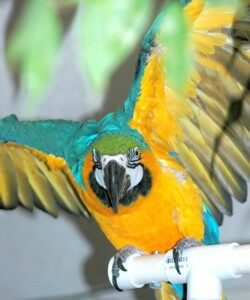
Corby exercising on his playpen.
My First Macaw
When my first large parrot, a Blue and Gold macaw, petitioned to joined the family I realized I had no idea how to handle a 30-inch-long bird with a beak that can crack a broomstick. So, I began learning. For me, developing a relationship with this intelligent and sensitive, yet powerful, creature was very different from the ones I had with my dogs and cats.
Building Trust
It was apparent to me that my first Blue and Gold macaw and I were building deeper levels of trust between us one experience at a time. As I became more confident and my competency grew when handling him this bird began understanding that he was safe with me. Regardless of where we were or what was going on around us – he was safe with me. In return I became skilled at being able to understand the subtle signs distinguishing the difference between when he would enjoy being involved in certain activities and when he preferred being left where he was. For us trust grew from a place of mutual respect as we learned to feel safe with each other.
The First Step
When ever a new parrot is rescued, and joins our family, the first thing I do is to start teaching them to eat and enjoy new, healthier foods. And the more I do this, the easier it becomes. For more info on how I do this please follow this link and read: “Feeding Parrots: Be Successful When Introducing New Food – Part 1.
To the Best of Health for You and Your Flock!
![]()
